Project Budokan Intro + Part 1: Beauty Is Power
A Not So Brief History of Joshi Wrestling in Nippon Budokan Hall... Begins!
Prologue
Sometimes, I try to invest my time into things that aren’t just professional wrestling.
I know this statement might sound insane to people reading this who know me personally–or even those of you who have merely interacted with me online–but it’s true. I enjoy many things outside the beautiful sport of pro wrestling. In fact, I have spent a lot of time in recent months trying to find new things that interest me as much as possible. However, somehow, I always seem to find myself back in that bubble, thinking about my borderline-obsessive hobby.
One recent example of this comes from the world of music. Sometime within the past year, I began listening to a J-pop group called Atarashii Gakko no Leaders, known in the West as simply ATARASHII GAKKO. After hearing one of their songs online, I was instantly hooked. I found their melodies fascinating, their group dynamic charming, and their choreography magnificent. By the end of last year, they were among my most listened-to artists of 2023. AG had quickly become one of my favorite performing acts, be it musically or otherwise, in the entire world, and I had clearly not been the only person hooked by their work.
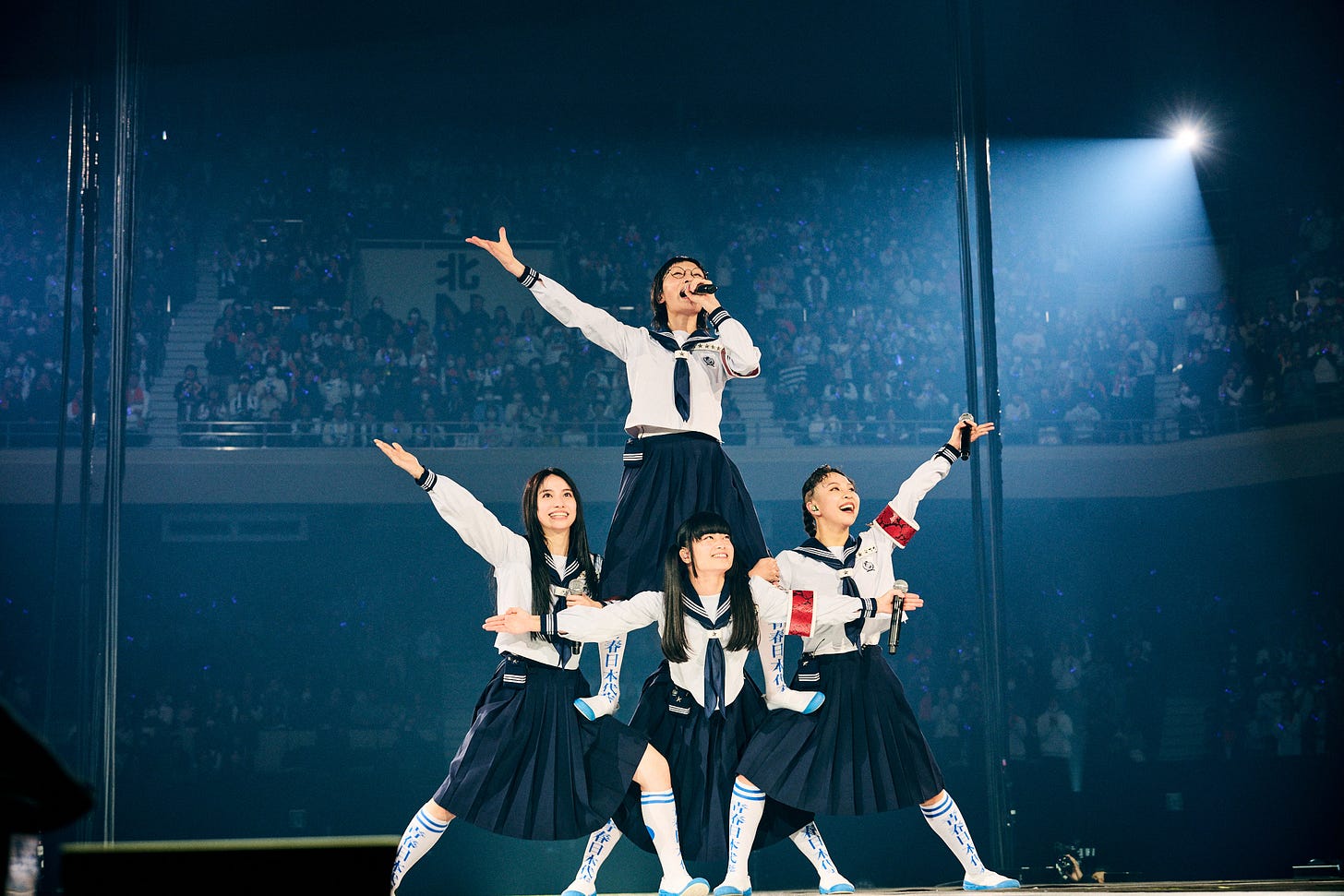
As 2024 came around, I saw posts and advertisements for an ATARASHII GAKKO concert, touted as their largest solo performance to date. From the clips I saw after the fact, the venue was spectacular, with the 12,000 fans in attendance boisterous and supportive of the girl group. When I went to see what venue this beautiful concert took place in, I quickly learned that they were performing in Nippon Budokan Hall, one of the most legendary arenas in Japan…
Nippon Budokan…
Budokan Hall…
I know A LOT about Budokan Hall…
Ah shit, here we go again.
Introduction
Budokan Hall is one of the most legendary buildings in combat sports history. While the Tokyo venue has grown to feature fewer sporting events and more musical acts in recent years, its name value has only continued to skyrocket in the sports world, especially amongst wrestling fans.
Professional wrestling first appeared inside Nippon Budokan in 1966, merely two years after the building was established. Since that inaugural event–a JWA show main evented by Giant Baba and Fritz Von Erich1–Budokan Hall has hosted an additional 253 wrestling shows promoted by 13 unique wrestling companies. Of those events, 11 featured all-women’s cards, with AJW and STARDOM being the only two joshi promotions to run solo events inside the legendary hall.
Despite the scarcity of events in the building, Joshi wrestling’s history within Nippon Budokan is both extensive and fascinating. Nippon Budokan has played host to some of joshi wrestling's most pivotal moments, ranging from incredibly good to infamously bad. When you look across all eleven joshi wrestling events within Budokan Hall, windows into the history of joshi wrestling can be seen.
So, in this series, I plan to discuss that history, from the inaugural all-women's events in the 1970s to STARDOM's sole event in the arena over four decades later. In doing so, I hope to shed some light on what Nippon Budokan has meant to joshi wrestling history and, potentially, its future.
And, I mean, it’s only eleven shows. Surely, it can't take THAT long, right?
Part I: Beauty Is Power
Chapter One: 11.1.1977
Before we dive right into our discussion, I want to talk more about Nippon Budokan as a venue. More specifically, I want to discuss the history of women’s combat sports inside the venue... or, rather, the lack thereof. While both Women’s Judo and Women’s Karate recently appeared inside Nippon Budokan as a part of the 2020 Tokyo Olympic Games, it was quite rare to see women’s combat sports take place within the building for several decades after it was built.
To start, let’s talk about judo. The sport that started it all for Budokan Hall, the venue opened in 1964 specifically with judo competitions in mind. While the male judokas took the stage inside Budokan Hall at that year’s Olympics and every year that followed for the annual All-Japan Judo Championships, its female counterpart–the Empress Cup–didn’t take place inside Nippon Budokan for decades, first appearing in the legendary venue in 2006 for its 21st edition.2
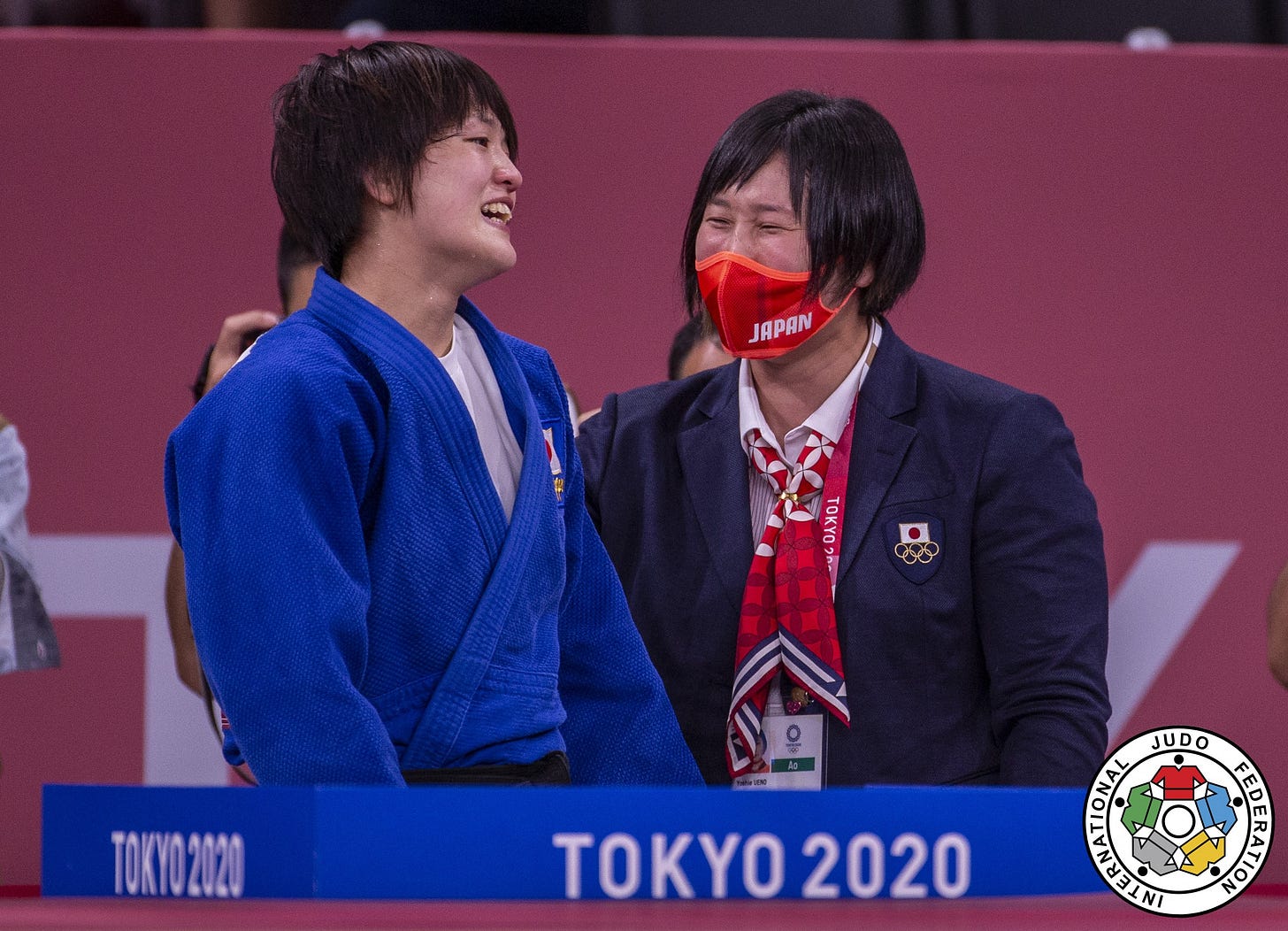
Meanwhile, Karate is a similar yet slightly more complicated story. While female karate practitioners began taking part in karate demos (better known as “Kata”) quite early, with the event first taking place at the 1974 JKA All-Japan Karate Championship inside Budokan Hall, women were not permitted to compete in the more physical aspects of the sport at that time. Instead, it took over a decade for women to participate in competitive sparring (better known as “Kumite”) inside the sacred hall, with the first female Kumite competition at the Karate Championships not occurring until 1987.3
All this is to say that the women of combat sports didn’t leave much of a footprint inside Budokan Hall throughout the 1960s and 1970s. Hell, even my brief research regarding women's Kendo wasn’t telling me much different from what I had found elsewhere. So, to say AJW’s debut in the venue in 1977 was monumental would be a bit of an understatement. Regardless of your stance on whether or not pro wrestling falls under the combat sports umbrella, AJW's first show inside Nippon Budokan stands as a first-of-its-kind event for the Japanese mecca of combat sports. Safe to say, AJW couldn't have pulled it out without the power and influence of two women: Maki Ueda and Jackie Sato, also known as the Beauty Pair.
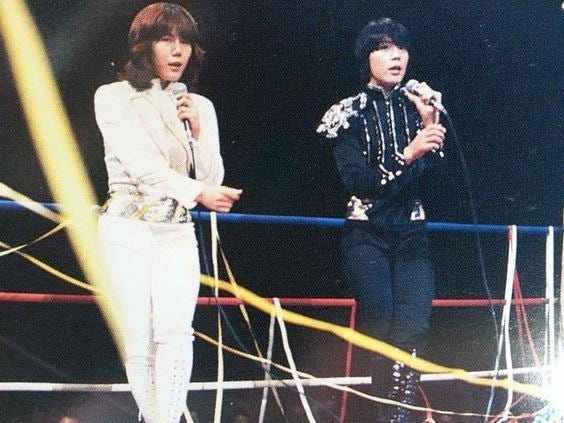
The 1970s featured AJW’s first true boom period, with the indomitable Beauty Pair dominating the conversation throughout the second half of the decade, and for good reason. The trailblazers were two of the first true crossover stars in wrestling history, with their concerts, stage performances, and in-ring work piercing through the hearts of young women in Japan and creating a new formula to build megastars in AJW.
With the help of that crossover appeal, Maki Ueda and Jackie Sato made women’s wrestling in Japan a hot topic, leading them to be the primary draws for AJW as they booked larger buildings to house all of the ‘Pair’s adoring fans. The biggest of these venues at the time was Nippon Budokan, an arena that AJW ran three times throughout the decade, with all three events featuring one or both members of the Beauty Pair in the main event of the evening.
The issue with the initial three events is that it is incredibly difficult to find much substantial footage of any of them, as is the case with most joshi wrestling before 1979. However, The cards alone paint a pretty easy picture of what transpired across the three events quite well.
On November 1st, 1977, AJW drew their biggest recorded attendance up to that point, with 13,000 fans gathered to watch Jackie Sato challenge her Beauty Pair ally Maki Ueda for the 3WA Singles Championship. Ueda was enjoying her second reign as AJW’s top champion, outpacing her tag team partner when it came to title reigns. In fact, Jackie Sato was looking to win her first recorded singles championship to date when she walked into her very first Budokan Hall main event.
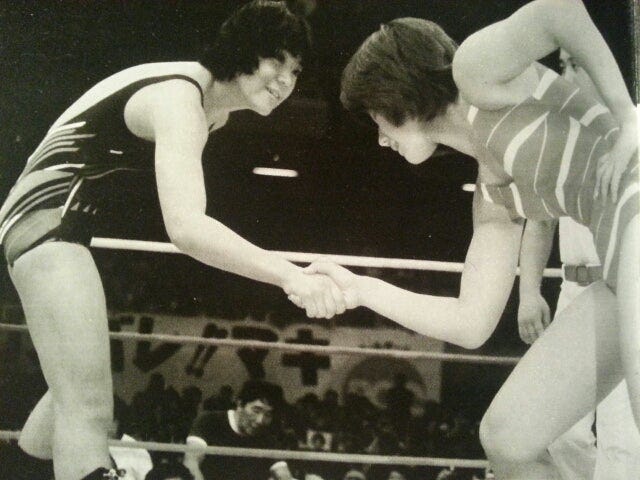
As for Ueda, while she was the reigning world champion, it’s important to note that she had never defeated Jackie Sato in singles competition up to that point. Instead, in the few noted one-on-one encounters the ‘Pair had in the mid-70s, all of them went to time-limit draws. So, unsurprisingly, it was deemed that even if the time limit expired in the main event of AJW’s inaugural Nippon Budokan event, the match must have a winner. And, instead of abolishing the time limit altogether, it was decided that the legendary Mildred Burke–who created the 3WA World Singles Championship decades earlier4–would act as the judge of the bout if neither woman could claim a decisive fall within one hour.
What transpired, while not readily available to view nowadays, was considered by some fans to be the Beauty Pair’s best singles match ever.5 13,000 strong inside Budokan Hall bore witness to Maki Ueda and Jackie Sato clashing for 60 grueling minutes, with the final decision being that Sato was the ultimate victor. While she couldn’t pin nor submit her comrade, she had finally defeated her and won the elusive 3WA Singles Championship.
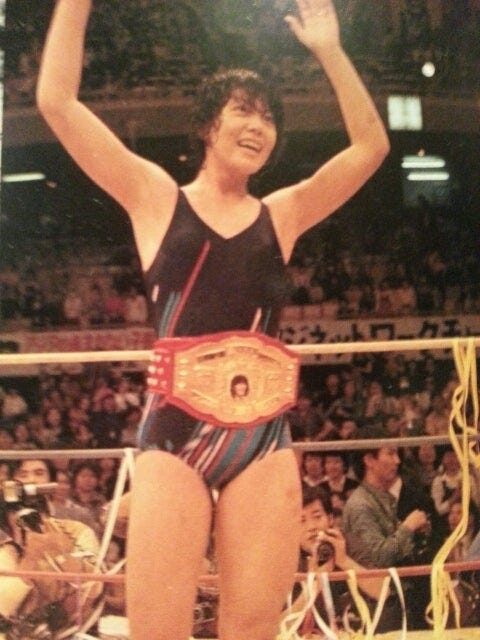
The legendary clash between the Beauty Pair was accompanied by a semi-main event that, while not being of the utmost importance, did feature some major names to look out for at that time. The team of Victoria Fujimi and Yumi Ikeshita faced off against the duo of Mariko Akagi and Nancy Kumi in a ⅔ falls match. Interestingly enough, while Fujimi and Ikeshita were representing the Ikeshita-led Black Army at the time of this event, Victoria and Nancy Kumi would go on to form the Golden Pair just a few months later, quickly becoming a top tag team that took AJW by storm in the years to follow.
However, of this match’s four competitors, it’s Yumi Ikeshita that was perhaps the most noteworthy. The then-reigning WWWA Hawaiian-Pacific Champion claimed the deciding fall over Kumi to win the match. Furthermore, the Black Pair member was also the only competitor to remain unpinned by the end of the multi-fall encounter, putting her on a pedestal amongst the others in her match. While it’s hard to call this causation and not merely correlation, it should be noted that her winning ways at AJW’s first Nippon Budokan event would be followed up with an even bigger role in the second joshi show at the legendary venue just nine months later.
Chapter Two – 8.9.1978
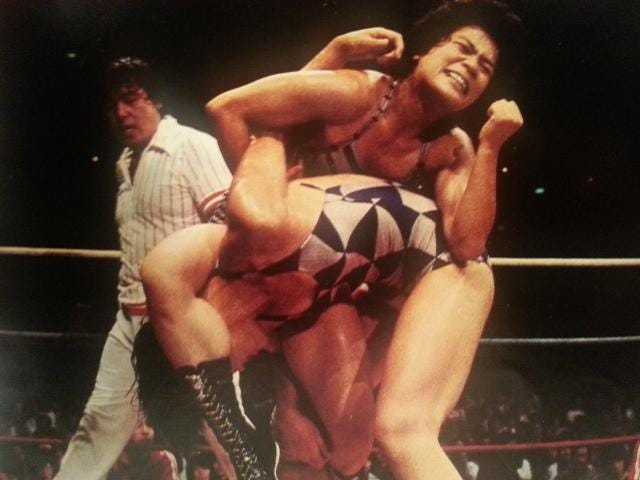
Of the first three joshi wrestling shows in Nippon Budokan, the second is the hardest to find a lot of details on. An event held as a celebration of AJW’s tenth anniversary, AJW’s return to the legendary hall featured a three-match card with all three WWWA Championships in existence at that time on the line. However, after some in-depth searching, not even one clip arose in regard to any of those three matches. Ultimately, due to the lack of information regarding the event, AJW's second outing in Nippon Budokan is often considered to be nothing more than a footnote in many reports and write-ups about this era of joshi wrestling. However, that, in some ways, takes away from the overall value of this remarkable card.
To start, the first WWWA Hawaiian-Pacific Championship match inside Nippon Budokan took place on August 9th, 1978, when ‘77 main eventer Maki Ueda challenged Chabera Romero for AJW’s secondary singles title. Romero, a Mexican star who had defeated Ueda (by disqualification) for the vacant title months earlier, was one of several top foreign heels that toured AJW during the late 70s and early 80s and was frequently at odds with both members of the Beauty Pair. While I could not retrieve footage of her match against Ueda, the negative reception she received a few years later in her Korakuen Hall bout against Jackie Sato helps paint the picture of how antagonistic she was towards the duo.
Nevertheless, Ueda ultimately vindicated her previous loss to Romero, dethroning the champion in less than 30 minutes. This victory meant that Ueda stood alone as the first person to have held the 3WA Hawaiian-Pacific, 3WA Singles, and 3WA Tag Team Championships in AJW history.
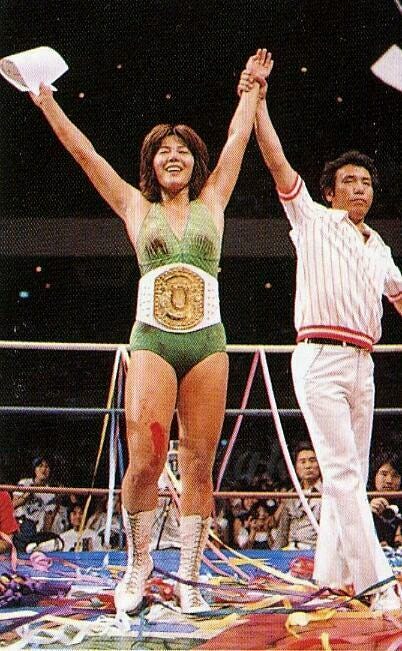
Speaking of AJW’s top tag team titles, the Golden Pair–who competed against one another the year prior–defended their 3WA Tag Team Championships against Lucy Kayama & Tomi Aoyama, known collectively as the Queen Angels. With the Beauty Pair-spawned tag team boom in full effect in AJW, Queen Angels and Golden Pair were two of several prevalent tag teams of this era, and their rivalry throughout the late 70s is critically acclaimed by those who got the chance to witness it firsthand. With that being said, this was the first meeting between the two duos after Aoyama and Kayama’s excursion to North America throughout the Summer months of 1978.6 This seemingly gave the Queen Angels the edge in this match as the Golden Pair ultimately lost their 3WA Tag Team Championships to Kayama & Aoyama two falls to one, with the deciding moments of the bout seeing the Queen Angles win the titles via countout.7 This marked the end of Fumiji & Kumi’s first and only 3WA Tag Team Championship reign as a duo at 184 days with one successful defense.
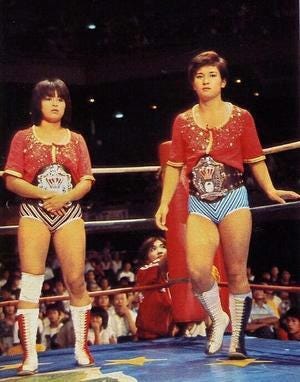
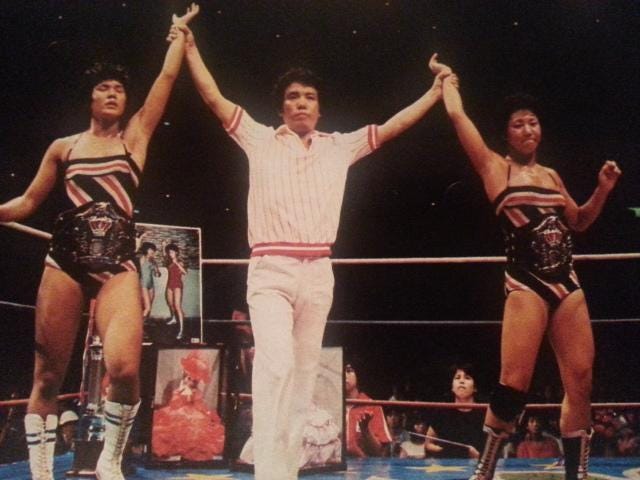
Then, in the main event, Jackie Sato returned to Budokan Hall with the 3WA Singles Championship around her waist when she faced long-time rival and former Hawaiian-Pacific Champion Yumi Ikeshita for AJW’s top prize. While the two were embittered in one of the most legendary rivalries of the decade, Beauty Pair vs Black Pair, this was their first singles championship bout on record. Ikeshita was seeking to join Ueda as an AJW Grand Slam Winner in this bout, but that was ultimately not in the cards for the Beauty Pair antagonist, who instead found herself engaged in a struggle that lasted sixty full minutes, with the time limit expiring for the second year in a row. However, unlike the previous AJW main event in Budokan Hall, no judge was present to make a decision, meaning that the match ended in a draw, and Sato walked away with the Red Belt still in her possession.
Chapter Three – 2.27.1979
While the first two All Japan Women’s Pro Wrestling events inside Nippon Budokan took place about a year apart from one another, it took merely six months for the company to return to the venue for their third year in a row. When they did, AJW did it with intent, with their final Budokan show of the 1970s also marking the end of an era for the promotion: The main event of the 1979 Budokan Hall event saw 3WA Singles Champion Jackie Sato once again facing off against her Beauty Pair comrade, Maki Ueda. This time around, however, the match would be contested under Loser Leaves Town rules, making it the last singles match the ‘Pair ever had against one another.
Due to Ueda vs. Sato being the only match on record for the February 27th AJW event, I suppose now would be a good time to talk a bit more about the Beauty Pair and why their participation in the first trilogy of all-women’s Nippon Budokan events was so pivotal. As I alluded to earlier, women’s combat sports were yet to be showcased on the sacred grounds of Nippon Budokan ahead of AJW’s inaugural events in the late 1970s. However, what I neglected to mention is that the other side of professional wrestling–the “Art” side of it, if you will–also had a long history of women being undervalued within Japan. In a tremendous blog written by NOAHsSAVIOR in 2021 about the Beauty Pair’s origins and their final match, they note that the modern history of women in theater was heavily affected by the nearly three-century ban on women performing in kabuki performances. This meant that the early 20th-century debut of the Takarazuka Revue, an all-women’s musical theater troupe, was truly revolutionary, with the group’s renditions of Rose of Versailles taking Japan by storm–especially the young women of that time. The success of these musicals became a major influence on AJW, with strategies and motifs used by the Takarazuka ultimately being used to make the Beauty Pair the crossover stars they became in the late 1970s.
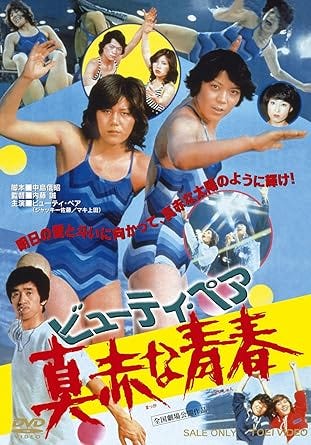
That was the briefest way I could properly get the information across, so I highly recommend you check out the full blog post over on I Say, You Say, Heisei to better grasp how these things pertain to the Beauty Pair. However, my point in bringing all of that up was to note further just how significant these first three events were for joshi wrestling and why I don’t think they could’ve happened with any two pioneers not named Maki Ueda and Jackie Sato.
In their final bout, which is the oldest Nippon Budokan women’s match readily available to view online, the Beauty Pair’s mastery of both performance art and technical combat was on full display, with the 10,000 fans in attendance, creating an atmosphere like no other for their last encounter. The ‘Pair made their entrances simultaneously, though from opposite sides of the arena, and after they both traversed through the sea of fans, they stood across from one another inside the ring, holding the original versions of both the Hawaiian-Pacific Championship and the WWWA Singles Championship, the latter of which was on the line.
The match itself saw work that was pretty standard for the time, with both women spending the majority of the match attempting to wear down their opponent with submissions and holds. That’s not to say it wasn’t riveting, however, as the crowd sat on the edge of their seats, painfully awaiting the fall that would put an end to their favorite duo. While Jackie Sato had control of both of Ueda’s legs, she utilized an Alligator Clutch, a move used by women’s wrestling legends Mildred Burke and Mae Young, to end the career of her tag team partner and retain the 3WA Singles Championship a quarter-century after Burke and Young first arrived to compete in Japan in 1954.89
After the match, Sato’s victory was met with simultaneous delight and horror, with fans of the duo both ecstatic about Jackie’s successful title defense and distraught by the fact that Ueda must now retire. Following her retirement ceremony and ten-bell salute, Ueda was joined by Sato to perform one last song together inside the ring, sending the 10,000 fans within Nippon Budokan home happy and definitively putting an end to one of the most influential tag teams in wrestling history.
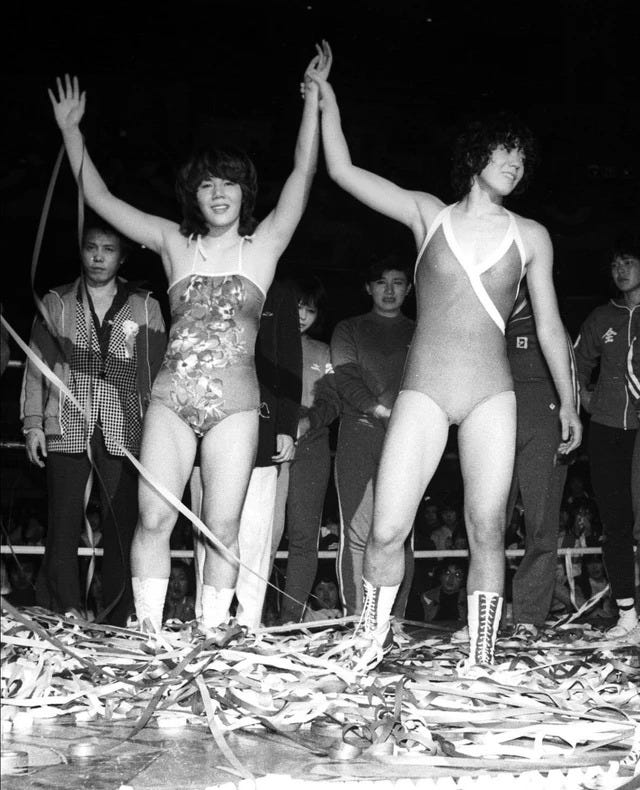
As a result of Ueda’s retirement, the Hawaiian-Pacific Championship went vacant for over 200 days before eventually returning to circulation in September 1979. Upon its return, the title was promptly renamed the All-Pacific Championship by backstage helper Rossy Ogawa.10 As for Jackie Sato, she remained atop the card in AJW, winning the 3WA Singles Championship for a second and third time before dropping the belt to Jaguar Yokota and being forced to retire in 1981 due to AJW’s age limit. To this day, Sato holds the record for total match time of any woman’s wrestler inside Budokan Hall with two hours and 48 minutes of competition across her three main event matches.
With the end of the Beauty Pair, so too came the end of AJW’s yearly Nippon Budokan events. While these first three shows are undeniably the least accessible of the bunch (and therefore the hardest to cover), their historical importance is as massive as they come in the world of joshi wrestling. With two of the three events featuring singles matches between one of, if not the, most important tag teams in joshi wrestling history, it’s easy to see why the inaugural three AJW events in Nippon Budokan were so important to cover. However, this is merely where the story begins. While 1979 was the last women’s Nippon Budokan event for over half a decade, their eventual return to the building in 1985 saw new stars, a new house style, and yet another significant event in the history of joshi wrestling.




